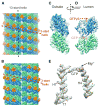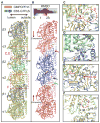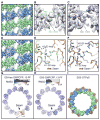Mechanistic Origin of Microtubule Dynamic Instability and Its Modulation by EB Proteins
- PMID: 26234155
- PMCID: PMC4537847
- DOI: 10.1016/j.cell.2015.07.012
Mechanistic Origin of Microtubule Dynamic Instability and Its Modulation by EB Proteins
Abstract
Microtubule (MT) dynamic instability is driven by GTP hydrolysis and regulated by microtubule-associated proteins, including the plus-end tracking end-binding protein (EB) family. We report six cryo-electron microscopy (cryo-EM) structures of MTs, at 3.5 Å or better resolution, bound to GMPCPP, GTPγS, or GDP, either decorated with kinesin motor domain after polymerization or copolymerized with EB3. Subtle changes around the E-site nucleotide during hydrolysis trigger conformational changes in α-tubulin around an "anchor point," leading to global lattice rearrangements and strain generation. Unlike the extended lattice of the GMPCPP-MT, the EB3-bound GTPγS-MT has a compacted lattice that differs in lattice twist from that of the also compacted GDP-MT. These results and the observation that EB3 promotes rapid hydrolysis of GMPCPP suggest that EB proteins modulate structural transitions at growing MT ends by recognizing and promoting an intermediate state generated during GTP hydrolysis. Our findings explain both EBs end-tracking behavior and their effect on microtubule dynamics.
Copyright © 2015 Elsevier Inc. All rights reserved.
Figures







References
-
- Akhmanova A, Steinmetz MO. Tracking the ends: a dynamic protein network controls the fate of microtubule tips. Nat Rev Mol Cell Biol. 2008;9:309–322. - PubMed
Publication types
MeSH terms
Substances
Grants and funding
LinkOut - more resources
Full Text Sources
Other Literature Sources

